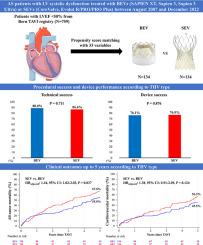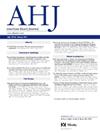左心室收缩功能障碍患者使用自膨式与球囊扩张式 TAVI 的五年疗效。
IF 3.7
2区 医学
Q1 CARDIAC & CARDIOVASCULAR SYSTEMS
引用次数: 0
摘要
背景:经导管心脏瓣膜(THV)设计对主动脉瓣狭窄(AS)和左心室收缩功能障碍患者临床预后的重要性仍然未知:我们旨在比较重度主动脉瓣狭窄和左心室射血分数(LVEF)降低的患者接受球囊扩张型和自扩张型主动脉瓣经导管主动脉瓣植入术(TAVI)的5年预后:方法:在伯尔尼 TAVI 登记处进行的一项回顾性分析中,纳入了 LVEF 低的患者:结果:2007 年 8 月至 2022 年 12 月间共纳入 759 例患者,通过倾向分数匹配得出 134 对患者。85%以上的患者获得了技术成功,两组患者的情况相似。自膨式 THV 与较低的平均跨瓣梯度相关(7.1 ± 3.7 mmHg vs. 9.9 ± 4.3 mmHg;P 调整值:1.44;95% CI:1.02-2.03;P = 0.037)。在长达5年的其他临床结果方面,两组之间没有明显差异:结论:在左心室收缩功能障碍的情况下,与接受球囊扩张型THV治疗的患者相比,接受自扩张型THV治疗的患者5年死亡风险更高。临床试验注册:https://www.Clinicaltrials: gov.NCT01368250。本文章由计算机程序翻译,如有差异,请以英文原文为准。

Five‐year outcomes with self‐expanding versus balloon‐expandable TAVI in patients with left ventricular systolic dysfunction
Background
The importance of transcatheter heart valve (THV) design on clinical outcome in patients with aortic stenosis (AS) and left ventricular (LV) systolic dysfunction remains unknown.
Objectives
We aimed to compare 5-year outcomes of patients with severe AS and reduced LV ejection fraction (LVEF), undergoing transcatheter aortic valve implantation (TAVI) with balloon-expandable vs. self-expanding THVs.
Methods
In a retrospective analysis from the Bern TAVI registry, patients with LVEF <50% who underwent TAVI with either balloon-expandable or self-expanding THVs were included. A 1:1 propensity-score matching was performed to account for baseline differences between groups.
Results
A total of 759 patients were included between August 2007 and December 2022, and propensity-score matching resulted in 134 pairs. Technical success was achieved in over 85% of patients, and was similar in both groups. Self-expanding THVs were associated with a lower mean transvalvular gradient (7.1 ± 3.7 mmHg vs. 9.9 ± 4.3 mmHg; P < .001) and a higher incidence of ≥mild-to-moderate paravalvular regurgitation (36.3% vs. 11.3%; P < .001) compared to balloon-expandable THVs. At 5 years, patients treated with a self-expanding THV had higher all-cause mortality than those with a balloon-expandable THV (67.8% vs. 55.8%, HRadjusted: 1.44; 95% CI: 1.02-2.03; P = .037). There were no significant differences in other clinical outcomes up to 5 years between groups.
Conclusions
In the setting of LV systolic dysfunction, patients treated with a self-expanding THV had higher risk of 5-year mortality compared to patients treated with a balloon-expandable THV.
Clinical Trial Registration
https://www.clinicaltrials.gov. NCT01368250.
求助全文
通过发布文献求助,成功后即可免费获取论文全文。
去求助
来源期刊

American heart journal
医学-心血管系统
CiteScore
8.20
自引率
2.10%
发文量
214
审稿时长
38 days
期刊介绍:
The American Heart Journal will consider for publication suitable articles on topics pertaining to the broad discipline of cardiovascular disease. Our goal is to provide the reader primary investigation, scholarly review, and opinion concerning the practice of cardiovascular medicine. We especially encourage submission of 3 types of reports that are not frequently seen in cardiovascular journals: negative clinical studies, reports on study designs, and studies involving the organization of medical care. The Journal does not accept individual case reports or original articles involving bench laboratory or animal research.
 求助内容:
求助内容: 应助结果提醒方式:
应助结果提醒方式:


